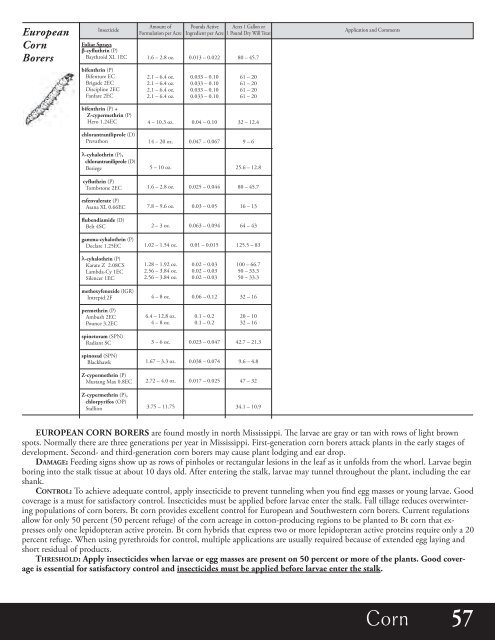Agronomic Crops
mJyPrJ
mJyPrJ
Create successful ePaper yourself
Turn your PDF publications into a flip-book with our unique Google optimized e-Paper software.
European<br />
Corn<br />
Borers<br />
Insecticide<br />
Foliar sprays<br />
b-cyfluthrin (P)<br />
Baythroid XL 1EC<br />
Amount of<br />
Formulation per Acre<br />
1.6 – 2.8 oz.<br />
Pounds Active<br />
Ingredient per Acre<br />
0.013 – 0.022<br />
Acres 1 Gallon or<br />
1 Pound Dry Will Treat<br />
80 – 45.7<br />
Application and Comments<br />
bifenthrin (P)<br />
Bifenture EC<br />
Brigade 2EC<br />
Discipline 2EC<br />
Fanfare 2EC<br />
2.1 – 6.4 oz.<br />
2.1 – 6.4 oz.<br />
2.1 – 6.4 oz.<br />
2.1 – 6.4 oz.<br />
0.033 – 0.10<br />
0.033 – 0.10<br />
0.033 – 0.10<br />
0.033 – 0.10<br />
61 – 20<br />
61 – 20<br />
61 – 20<br />
61 – 20<br />
bifenthrin (P) +<br />
Z-cypermethrin (P)<br />
Hero 1.24EC<br />
4 – 10.3 oz.<br />
0.04 – 0.10<br />
32 – 12.4<br />
chlorantraniliprole (D)<br />
Prevathon<br />
14 – 20 oz.<br />
0.047 – 0.067<br />
9 – 6<br />
λ-cyhalothrin (P),<br />
chlorantraniliprole (D)<br />
Besiege<br />
5 – 10 oz.<br />
25.6 – 12.8<br />
cyfluthrin (P)<br />
Tombstone 2EC<br />
1.6 – 2.8 oz.<br />
0.025 – 0.044<br />
80 – 45.7<br />
esfenvalerate (P)<br />
Asana XL 0.66EC<br />
7.8 – 9.6 oz.<br />
0.03 – 0.05<br />
16 – 13<br />
flubendiamide (D)<br />
Belt 4SC<br />
2 – 3 oz.<br />
0.063 – 0.094<br />
64 – 43<br />
gamma-cyhalothrin (P)<br />
Declare 1.25EC<br />
1.02 – 1.54 oz.<br />
0.01 – 0.015<br />
125.5 – 83<br />
λ-cyhalothrin (P)<br />
Karate Z 2.08CS<br />
Lambda-Cy 1EC<br />
Silencer 1EC<br />
1.28 – 1.92 oz.<br />
2.56 – 3.84 oz.<br />
2.56 – 3.84 oz.<br />
0.02 – 0.03<br />
0.02 – 0.03<br />
0.02 – 0.03<br />
100 – 66.7<br />
50 – 33.3<br />
50 – 33.3<br />
methoxyfenozide (IGR)<br />
Intrepid 2F<br />
4 – 8 oz.<br />
0.06 – 0.12<br />
32 – 16<br />
permethrin (P)<br />
Ambush 2EC<br />
Pounce 3.2EC<br />
6.4 – 12.8 oz.<br />
4 – 8 oz.<br />
0.1 – 0.2<br />
0.1 – 0.2<br />
20 – 10<br />
32 – 16<br />
spinetoram (SPN)<br />
Radiant SC<br />
3 – 6 oz.<br />
0.023 – 0.047<br />
42.7 – 21.3<br />
spinosad (SPN)<br />
Blackhawk<br />
1.67 – 3.3 oz.<br />
0.038 – 0.074<br />
9.6 – 4.8<br />
Z-cypermethrin (P)<br />
Mustang Max 0.8EC<br />
2.72 – 4.0 oz.<br />
0.017 – 0.025<br />
47 – 32<br />
Z-cypermethrin (P),<br />
chlorpyrifos (OP)<br />
Stallion<br />
3.75 – 11.75<br />
34.1 – 10.9<br />
eURoPeAn CoRn BoReRs are found mostly in north Mississippi. e larvae are gray or tan with rows of light brown<br />
spots. Normally there are three generations per year in Mississippi. First-generation corn borers attack plants in the early stages of<br />
development. Second- and third-generation corn borers may cause plant lodging and ear drop.<br />
DAMAGe: Feeding signs show up as rows of pinholes or rectangular lesions in the leaf as it unfolds from the whorl. Larvae begin<br />
boring into the stalk tissue at about 10 days old. After entering the stalk, larvae may tunnel throughout the plant, including the ear<br />
shank.<br />
ContRoL: To achieve adequate control, apply insecticide to prevent tunneling when you find egg masses or young larvae. Good<br />
coverage is a must for satisfactory control. Insecticides must be applied before larvae enter the stalk. Fall tillage reduces overwintering<br />
populations of corn borers. Bt corn provides excellent control for European and Southwestern corn borers. Current regulations<br />
allow for only 50 percent (50 percent refuge) of the corn acreage in cotton-producing regions to be planted to Bt corn that expresses<br />
only one lepidopteran active protein. Bt corn hybrids that express two or more lepidopteran active proteins require only a 20<br />
percent refuge. When using pyrethroids for control, multiple applications are usually required because of extended egg laying and<br />
short residual of products.<br />
tHResHoLD: Apply insecticides when larvae or egg masses are present on 50 percent or more of the plants. Good coverage<br />
is essential for satisfactory control and insecticides must be applied before larvae enter the stalk.<br />
Crop Name Corn 57


